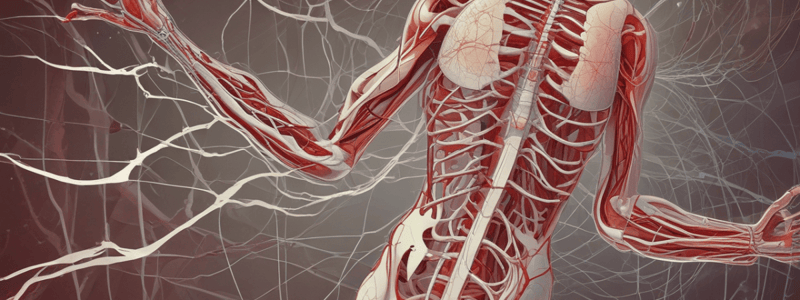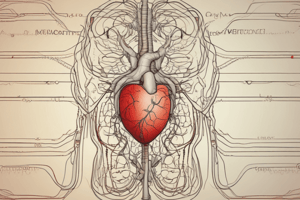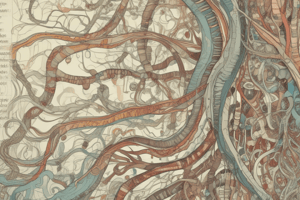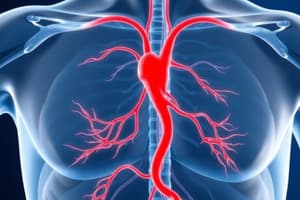Podcast
Questions and Answers
What happens to diastole when heart rate is increased?
What happens to diastole when heart rate is increased?
- It remains the same
- It becomes longer
- It disappears
- It becomes shorter (correct)
What is the primary mechanism by which coronary blood flow increases during exercise?
What is the primary mechanism by which coronary blood flow increases during exercise?
- Increased atrial contraction
- Increased sympathetic stimulation
- Accumulated metabolites causing vasodilation (correct)
- Increased parasympathetic stimulation
What is the percentage of cardiac output that is allocated to the coronary circulation at rest?
What is the percentage of cardiac output that is allocated to the coronary circulation at rest?
- 2%
- 1%
- 4% (correct)
- 5%
What happens to coronary blood flow during systole?
What happens to coronary blood flow during systole?
What is the effect of ischaemia on coronary collaterals?
What is the effect of ischaemia on coronary collaterals?
What is the effect of increased heart rate on diastolic pressure?
What is the effect of increased heart rate on diastolic pressure?
What is the relationship between diastole and coronary blood flow?
What is the relationship between diastole and coronary blood flow?
What happens to coronary arteriolar tone during exercise?
What happens to coronary arteriolar tone during exercise?
What is the effect of sympathetic stimulation on coronary arterioles?
What is the effect of sympathetic stimulation on coronary arterioles?
What is the relationship between cardiac output and coronary blood flow during exercise?
What is the relationship between cardiac output and coronary blood flow during exercise?
What is the primary effect of sympathetic nerves on blood vessels?
What is the primary effect of sympathetic nerves on blood vessels?
Which of the following hormones acts to decrease total peripheral resistance in response to increased blood volume?
Which of the following hormones acts to decrease total peripheral resistance in response to increased blood volume?
Which type of receptor is primarily involved in the parasympathetic regulation of blood flow?
Which type of receptor is primarily involved in the parasympathetic regulation of blood flow?
What is the primary effect of oxidative stress on blood vessels?
What is the primary effect of oxidative stress on blood vessels?
Under normal conditions, which neurotransmitter is more important in mediating the effects of the sympathetic nervous system on the cardiovascular system?
Under normal conditions, which neurotransmitter is more important in mediating the effects of the sympathetic nervous system on the cardiovascular system?
What is the characteristic of coronary flow reserve?
What is the characteristic of coronary flow reserve?
Which of the following organs is primarily regulated by the parasympathetic nervous system in terms of blood flow?
Which of the following organs is primarily regulated by the parasympathetic nervous system in terms of blood flow?
What is the primary effect of angiotensin II on the cardiovascular system?
What is the primary effect of angiotensin II on the cardiovascular system?
Why does right ventricular blood flow continue throughout the cardiac cycle?
Why does right ventricular blood flow continue throughout the cardiac cycle?
Which of the following is NOT a target of sympathetic nervous system-mediated vasoconstriction?
Which of the following is NOT a target of sympathetic nervous system-mediated vasoconstriction?
What happens to diastolic pressure during systole?
What happens to diastolic pressure during systole?
What is the effect of stenosis on coronary blood flow?
What is the effect of stenosis on coronary blood flow?
What is the compensatory mechanism for stenosis in coronary blood flow?
What is the compensatory mechanism for stenosis in coronary blood flow?
At what percentage of stenosis does vasodilatory autoregulation fail?
At what percentage of stenosis does vasodilatory autoregulation fail?
What is the effect of chronic stenosis on the microvasculature?
What is the effect of chronic stenosis on the microvasculature?
What is the result of prolonged ischaemia in coronary arteries?
What is the result of prolonged ischaemia in coronary arteries?
What is the relationship between DP and flow through the microvasculature?
What is the relationship between DP and flow through the microvasculature?
What is the effect of stenosis on DP?
What is the effect of stenosis on DP?
What is the primary reason for the constant cerebral blood flow requirement?
What is the primary reason for the constant cerebral blood flow requirement?
What is the equation that describes cerebral blood flow?
What is the equation that describes cerebral blood flow?
What is the result of a decrease in perfusion pressure in the cerebral arterioles?
What is the result of a decrease in perfusion pressure in the cerebral arterioles?
What is the primary mechanism that helps to regulate cerebral blood flow during changes in cardiac output and/or MAP?
What is the primary mechanism that helps to regulate cerebral blood flow during changes in cardiac output and/or MAP?
What is the result of increased CO2 in the cerebral arterioles?
What is the result of increased CO2 in the cerebral arterioles?
What is the purpose of flow auto-regulation in the cerebral circulation?
What is the purpose of flow auto-regulation in the cerebral circulation?
What is the result of increased perfusion pressure in the cerebral arterioles?
What is the result of increased perfusion pressure in the cerebral arterioles?
What is the myogenic mechanism responsible for in the cerebral circulation?
What is the myogenic mechanism responsible for in the cerebral circulation?
What is the consequence of too much blood flow to the cerebral vessels?
What is the consequence of too much blood flow to the cerebral vessels?
What is the purpose of the negative feedback mechanism in the cerebral circulation?
What is the purpose of the negative feedback mechanism in the cerebral circulation?
What is the primary function of vascular tone in the body?
What is the primary function of vascular tone in the body?
Which of the following factors does NOT contribute to vascular tone?
Which of the following factors does NOT contribute to vascular tone?
What is the primary mechanism by which the vascular endothelium regulates vascular tone?
What is the primary mechanism by which the vascular endothelium regulates vascular tone?
What is the result of endothelial dysfunction on vascular tone?
What is the result of endothelial dysfunction on vascular tone?
What mechanism allows arteries to maintain a constant blood flow over a wide range of pressures?
What mechanism allows arteries to maintain a constant blood flow over a wide range of pressures?
What allows tissues to regulate their own blood supply?
What allows tissues to regulate their own blood supply?
When does coronary blood flow to the left ventricle occur mainly?
When does coronary blood flow to the left ventricle occur mainly?
What is the result of increased cardiac work on coronary blood flow?
What is the result of increased cardiac work on coronary blood flow?
Study Notes
Autonomic Nervous System (ANS) and Blood Flow Regulation
- Sympathetic nerves cause vasoconstriction, especially in splanchnic, renal, cutaneous, and muscle vascular beds, mainly via noradrenaline and α1 receptors.
- Parasympathetic nerves cause vasodilatation in specific organs, such as salivary glands, pancreas, intestinal mucosa, and penis, mainly via acetylcholine and muscarinic receptors.
Circulating Hormones and Blood Pressure Regulation
- Anti-diuretic hormone (vasopressin) from the posterior pituitary raises total peripheral resistance (TPR) in response to reduced blood volume.
- Angiotensin II raises TPR in response to reduced blood volume, while atrial natriuretic peptide (ANP) lowers TPR in response to increased blood volume.
Special Requirements of the Cerebral Circulation
- Cerebral blood flow must remain relatively constant, despite changes elsewhere in the body, to maintain constant brain metabolic demand.
- Flow auto-regulation ensures that cerebral blood flow is tightly controlled, responding to changes in perfusion pressure and CO2 levels.
Mechanism of Cerebral Flow Autoregulation
- Cerebral arterioles respond to changes in perfusion pressure and CO2 levels, constricting or dilating to maintain constant blood flow.
- Negative feedback mechanisms, such as increased CO2 washout, help regulate cerebral blood flow.
Coronary Blood Flow Regulation
- Coronary blood flow varies during the cardiac cycle, peaking during diastole and falling to zero during systole.
- Increased metabolic demand and oxygen consumption in cardiac muscle lead to vasodilation and increased coronary blood flow.
- Active hyperaemia in cardiac muscle is mediated by sympathetic nervous system activation, adenosine, and increased metabolite production.
Compensatory Mechanisms in Coronary Blood Flow
- Coronary collaterals form in response to ischaemia, promoting blood flow to the affected area.
- Vasodilatory autoregulation compensates for increased resistance caused by stenosis, but only up to a point.
- Prolonged ischaemia leads to the development of intra-arterial collaterals between coronary arteries.
Studying That Suits You
Use AI to generate personalized quizzes and flashcards to suit your learning preferences.
Description
Learn about the role of the autonomic nervous system in regulating blood flow, including the effects of sympathetic and parasympathetic nerves on vasoconstriction and vasodilation. Also, explore the role of circulating hormones in blood pressure regulation.




